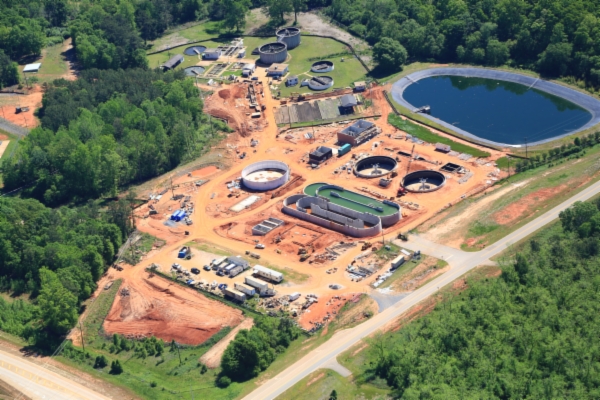
City of Barnesville invests $12.5 for the construction of the James A. King Wastewater Treatment Facility. In January 2013, The City of Barnesville awarded H.C. Coleman & Company, Inc. a twelve million five hundred sixty-nine thousand seven hundred dollar ($12,569,700) contract to construct the Facility.
The plant will replace the existing Wastewater Treatment Plant which is more than 30 years old, reaching maximum capacity of 1.2 MGD and unable to meet the tightening limits set by the EPD. The current 1.2 MGD trickling filter plant exceeded its permitted flow five of six months during the six month period of December 2009 thru May 2010. In the drier months capacity was at 75%. The projected flow increases over the next three years would exceed the permit limits every month of the year. The plant is also becoming so outdated that repairs on such a facility are not economically feasible.
As construction on the new 2.4 MGD wastewater treatment plant is now entering its fifth month, the City’s desire to build a state of the art facility is coming to fruition. The city began the process of planning for the new treatment facility more than 10 years ago. The planning process included site selection, selection of treatment processes and most importantly identifying funding mechanisms.
Several locations were evaluated to determine the best possible site for the plant. The City evaluated the city’s current sewer system to determine the need for additional piping and liftstations at two other locations. After careful consideration, the city opted to construct the new plant adjacent to the current facility which required no additional piping and the EPD had agreed to allow the additional discharge. Once the new plant comes online the old plant will be decommissioned.
The new 2.4 MGD facility, designed by Stevenson & Palmer Engineering, Inc. will be a OxyStream™ Biological Nutrient Removal (BNR) System that utilizes auger-type screening as primary treatment; oxidation ditch and clarifiers for secondary treatment; followed by cloth filters and ultraviolet disinfection for tertiary treatment. Solids will be treated by aerobic digestion followed by sludge dewatering via a press.
The permit for the new plant allows for a discharge of 2.4 MGD of treated effluent into Tobeesofkee creek. However, 0.7 to 1.2 MGD will be diverted to the city’s newest industry, Piedmont Green Power (PGP). PGP will use the treated effluent as coolant water at the 53.5 megawatt Biomass Power Generation Plant. PGP has a contract with Georgia Power to generate green power for the next 20 years. The sale of the treated reuse water will generate new revenue available for the bond debt service in addition to other financial impacts that a large industry has on a community.
The City’s leaders researched and analyzed several different methods to fund this project. These methods were GEFA loans, USDA Loans, SRF Loans, Water and Sewer Revenue Bonds and American Reinvestment and Recovery Act (ARRA) funds. Ultimately the City decided to issue revenue bonds due to the low interest rate and the ability to consolidate other Water and Sewer ventures. The City was proud to receive a AA- rating from Standard and Poor’s during the evaluation of the City’s credit worthiness. This rating was crucial when the bonding agency set the interest rate on the bonds and to helped ensure investor participation.
The City recognized that in order to meet the needs of our current citizens and businesses, meet EPD limitations and remain a viable prospect for economic development, the City must construct a new wastewater treatment facility. With the continued growth or our community, the city would reach maximum capacity within the next couple of years.
“If we are unable to meet this basic need of the community we have failed in our in role to prepare for and manage for the future needs of our citizenry. Our residents expect and depend on the City to provide these services,” stated City Manager Kenneth D. Roberts.
Construction of the new plant is expected to be complete by August 2014.




